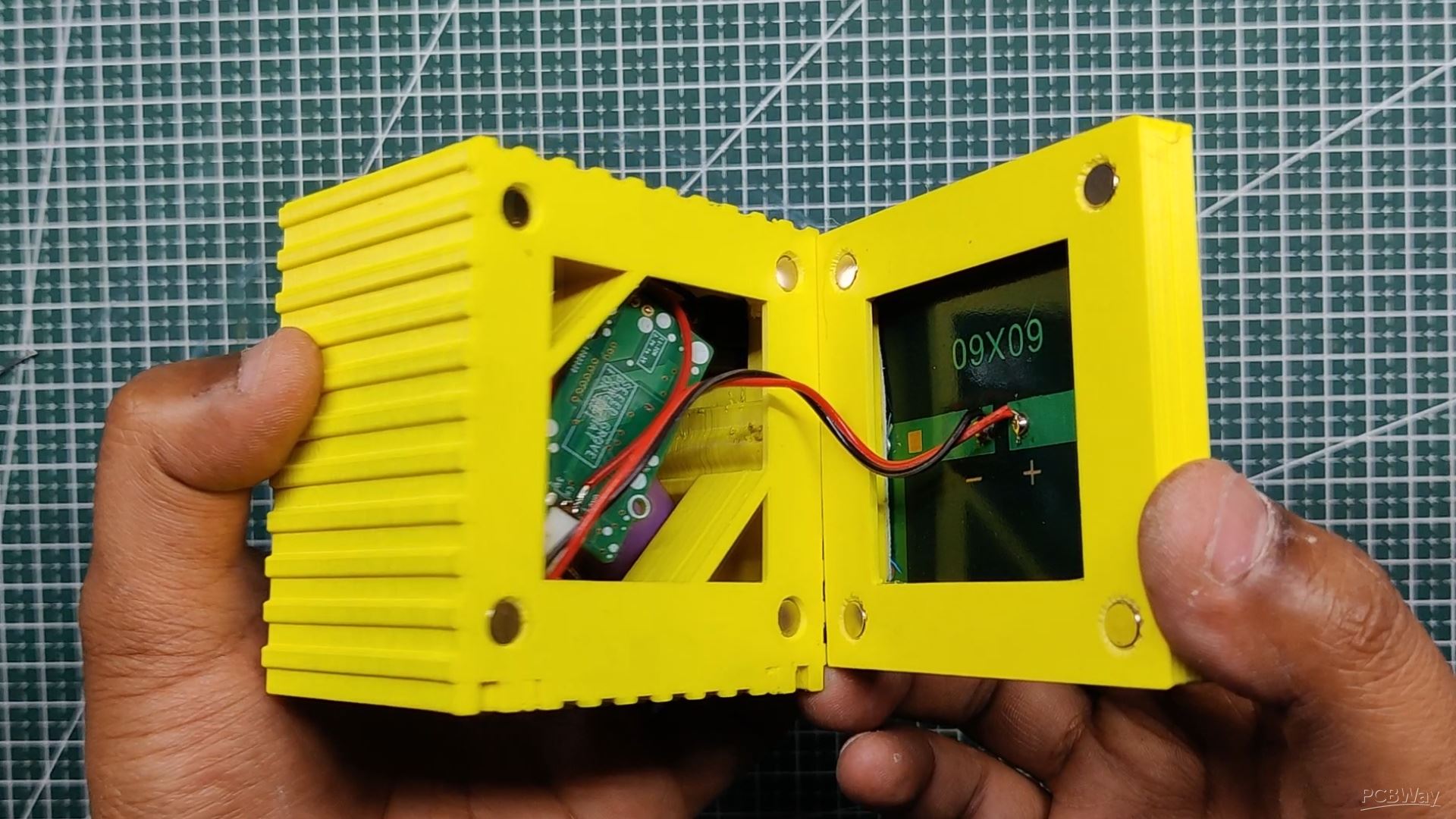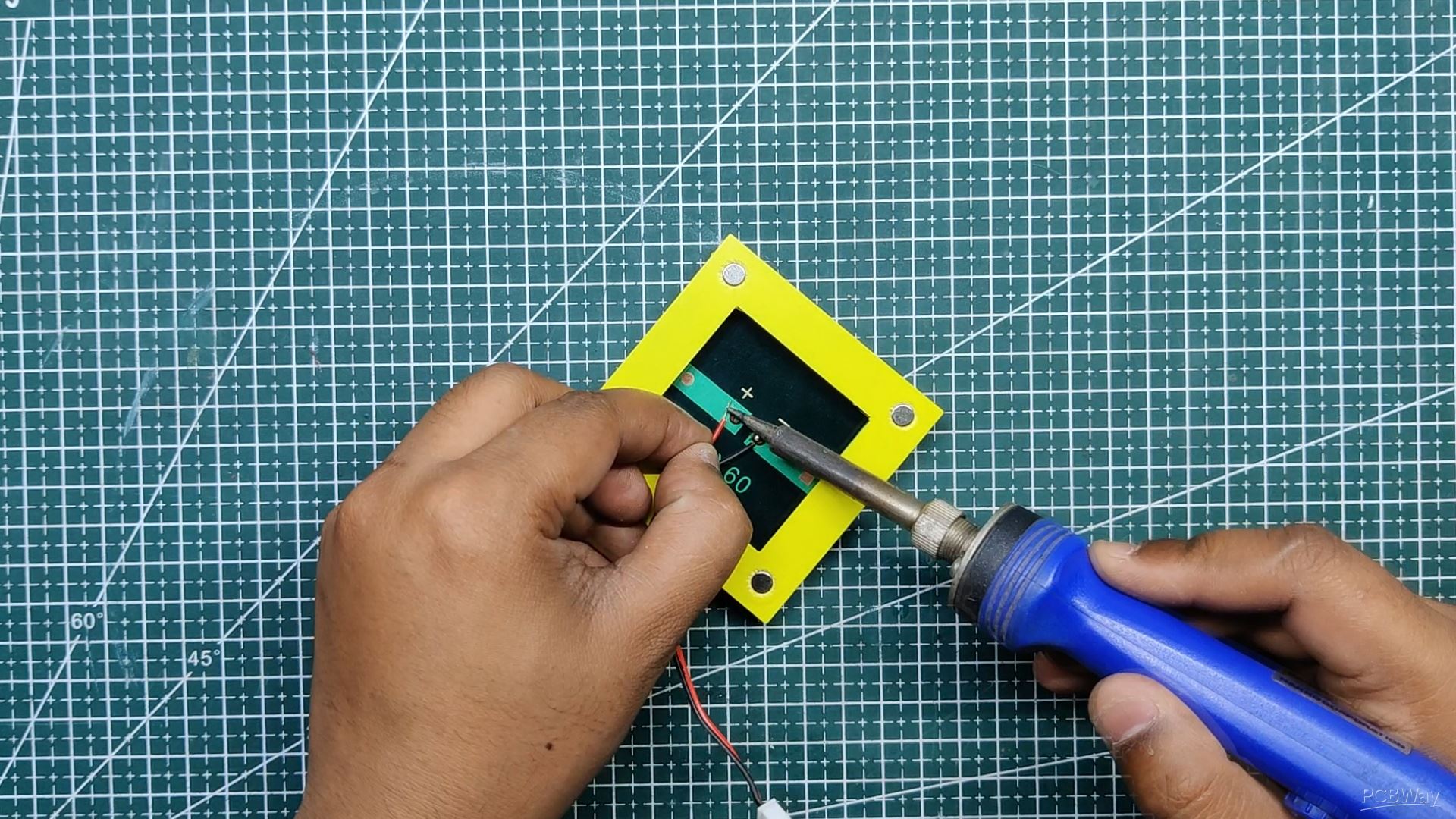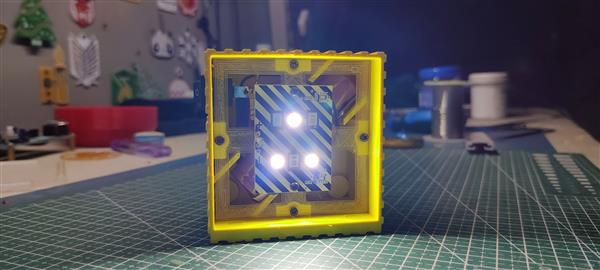Mini Solar Light Project with a Twist
Greetings.


This is the Cube Light, a Small and compact cube-shaped emergency solar light that boasts a power output of 3 watts. The light is equipped with a high-efficiency 5V 80mA solar panel, intelligently positioned on the backside of the cube. To ensure convenience and versatility, I have ingeniously integrated four magnets, allowing for seamless attachment and detachment of the solar panel from the main body of the light.
This magnetic connection ensures a secure and reliable bond while still allowing for effortless repositioning and orientation adjustment to maximize solar exposure. Overall, my innovative solar light design not only presents a sleek and practical form factor but also prioritizes functionality and ease of use in emergency situations.

The primary objective behind the development of this portable 3W emergency solar light was to create a versatile and reliable lighting solution that could effectively address two common scenarios: blackouts and camping. By integrating a compact and lightweight design, this solar light offers exceptional portability, allowing it to be easily carried and used in various situations. During blackouts, when traditional power sources are unavailable, this solar light serves as a dependable alternative, ensuring continuous illumination to navigate through darkened spaces and provide a sense of security.
Moreover, for outdoor enthusiasts and campers, this light proves to be an invaluable companion, offering a convenient and sustainable lighting option that harnesses the power of the sun.
This Article is about the complete built process of this light, so let's get started with it.
Materials Required
These were the components used in this project:
- Solar Panel 5.5V 80mA
- IP5306 Power Module
- Battery: 3.7V, 1200mAh
- 3D-printed parts
- Magnets
- Double sided tape
- JST Wire harness
3D Design

We first started this project by preparing a simple yet functional design in the shape of a cube.
Inside this design, we have incorporated an 18650 Lithium cell, which is connected with an LED Load in front and a solar panel on the back side.
One of the major aspects or key features of this project was the detachable solar panel module, which can be replaced with a much higher power panel because of its detachable feature.
The whole design was made in fusion360 and here's how this design was made:
With Fusion360, we initially created the designs for the LED PCB, battery, and solar panel. When components are designed first, placement and design become simpler and more obvious because we only need to create bodies around already-designed components.
After attaching the parts, we create the mid-body, which will house the battery and another component—the LED Holder. The LED Holder, which will be housed inside the body and used to hold the LED PCB, will also serve as a closing cover to keep the lithium cell in position.
Next, we model a solar panel holder with four magnets located close to each edge. The magnets won't be held in place by anything other than a snug fit.
The solar panel will be held in place using double-sided tape.
After finalizing the design, we export all parts and then use CURA to slice all the mesh files and then 3D print them using my good old ENDER 3.
Yellow PLA was used with a 0.4mm Nozzle and a 0.2mm Layer height.
Solar Panels from PCBWAY Giftshop


As for sourcing components for this project, I got the Solar Panel used in this project from PCBWAY's GIFTSHOP.
https://www.pcbway.com/project/gifts_detail/5_5V_80mA_Solar_Panel_DIY_Solar_01eb2eab.html
PCBWAY Gift Shop is an online marketplace where you can get a variety of electronics modules and boards for their genuine price, or you could use the PCBWAY currency, which is called beans.
You get beans after ordering something from PCBWAY as reward points, or you can also get them by posting any project in the PCBWAY community.
Check PCBWAY out for great PCB service from here: https://www.pcbway.com/
Adding Magnets to Hold Solar Panel Holder and Mid Body



In this project, we are using Shiny round ferrite magnets, also known as ceramic magnets, which are a type of permanent magnet made from a composite of iron oxide and barium or strontium carbonate. They are known for their relatively low cost, high coercivity, and resistance to demagnetization.
- We first arrange them together to begin the magnet assembly; two pairs are needed for each edge.
- In order to first attach four components to the midbody and then add the same pair to the solar holder, we mark each pair after that.
Solar Panel Holder Assembly





- Placement of the panel in the 3D-printed holder with double-sided tape.
- Next, we connect the wire harness's positive and negative terminals with the solar panel's PV+ and PV- using a regular soldering iron.
Testing

After soldering the wires to the panel's PV terminals, we measure the voltage of the panel, which is 4.0V under light; when this panel is exposed to sunshine, we receive a maximum of 5.5V.
LED Load PCB Assembly



- In the process of installing LEDs, we reuse an LED MCPCB from an older project, add solder paste to its component pads, and select and position the LEDs.
- In this configuration, three Cree 3V/1W LEDs total are used, and they are wired in parallel.
- The PCB is then placed on a miniature reflow hotplate, which heats it from below until the solder melts. As soon as the PCB reaches that temperature, the solder melts and all of the components are soldered to their pads.
- Adding Switch to middle Body
We then add a rocker switch (SPST) to the midbody, which has a 19x13mm slot specifically designed for it. The two latches on the rocker switch's two faces, which firmly grab the body from the inside, keep it in place.
Main Circuit

I use an IP5306-based charge module, which has a 5V output, an LED indication feature, and many other crucial features, to regulate the charge and discharge of Li-ion batteries.
The IP5306 is a power module IC that provides comprehensive power management capabilities for portable electronic devices. It is commonly used in applications such as smartphones, tablets, portable media players, and other battery-powered devices.
The IP5306 integrates multiple functions into a single chip, making it a compact and efficient solution for power management. Some of its key features include:
- Battery Charging: The IP5306 supports various charging modes, including constant current and constant voltage charging, ensuring efficient and safe charging of the device's battery. It also includes features like overvoltage protection and overcurrent protection to safeguard the battery during charging.
- Power Path Management: The power path management feature allows the device to operate even when the battery is low or absent. It can prioritize power delivery from the battery or external power source, ensuring uninterrupted operation and optimal battery usage.
- Power Supply Regulation: The IP5306 regulates the voltage levels of various power supplies within the device, such as the main power source and auxiliary power sources. This helps maintain stable voltage levels for different components and prevents damage due to voltage fluctuations.
- System Monitoring: The IC includes a monitoring circuit that continuously tracks parameters such as battery voltage, current, and temperature. This information can be used for battery capacity estimation, thermal management, and system performance optimization.
- Efficiency Optimization: The IP5306 is designed to maximize power conversion efficiency, reducing energy wastage and extending battery life. It employs advanced techniques like pulse-width modulation (PWM) to control power delivery and minimize power dissipation.
- Overall, the IP5306 power module IC offers a reliable and integrated solution for power management in portable electronic devices.
Wiring


- The wiring for this setup is extremely straightforward: the positive and negative terminals of the lithium battery go into the battery CON of the IP5306 Module, the JST connector added to the IP5306 Module connects to the solar module, and the LED load is connected directly to the battery with a resistance in series to control the current flowing through the LED load.
- Between the positive of the battery and the positive of the LED load, a rocker switch is placed.
- The battery already has a PCM module connected to it that will cut off the battery output voltage once the battery voltage hits 2.8 volts, so there is no need to connect the LED Load directly to the battery.
LED Load Placement with Mid Body



- Following wiring, we attach an LED Holder there with four M2 screws.
- Using the same M2 screws, we next attach the LED PCB to the LED Holder, link the positive from the switch to the positive of the LED load, and connect the resistor to the GND of the LED load. Here, a 1.5-ohm, 2-watt resistor is being used.
RESULT

Here's the result of this small build: a small portable Solar Light that can be used during blackouts, camping, or just to illuminate anything anywhere, anytime.
The primary advantage of this system was the detachable panel setup. We could create a separate module to fit a different panel and attach it to the current system without altering the body structure. To replace the existing solar panel, we only need to create a new solar panel holder.
Conclusion

This project is functional, but there are a lot of changes that need to be made, like LED Diffusion (or light dispersion), a suitable holder, and even an LED Driver.
These changes will be rectified in version 2 of this project, so stay tuned for that.
Do leave a comment if you need any help regarding this project.
This is it for today folks.
Thanks PCBWAY for supporting this project, you guys can check them out if you need great PCB and stencil service for less cost and great quality.
And I'll be back with a new project pretty soon!
Mini Solar Light Project with a Twist
- Comments(0)
- Likes(1)
-
 Anthony Pedotto
Feb 22,2025
Anthony Pedotto
Feb 22,2025
- 0 USER VOTES
- YOUR VOTE 0.00 0.00
- 1
- 2
- 3
- 4
- 5
- 6
- 7
- 8
- 9
- 10
- 1
- 2
- 3
- 4
- 5
- 6
- 7
- 8
- 9
- 10
- 1
- 2
- 3
- 4
- 5
- 6
- 7
- 8
- 9
- 10
- 1
- 2
- 3
- 4
- 5
- 6
- 7
- 8
- 9
- 10
 More by Arnov Arnov sharma
More by Arnov Arnov sharma
-
 Pocket SNES
Greetings everyone, and welcome back! Today, I’ve got something fun and tiny to share—the Pocket SNE...
Pocket SNES
Greetings everyone, and welcome back! Today, I’ve got something fun and tiny to share—the Pocket SNE...
-
 Batocera Arcade Box
Greetings everyone and welcome back, Here's something. Fun and nostalgic. Right now, we are using ou...
Batocera Arcade Box
Greetings everyone and welcome back, Here's something. Fun and nostalgic. Right now, we are using ou...
-
 64x32 Matrix Panel Setup with PICO 2
Greetings everyone and welcome back.So here's something fun and useful: a Raspberry Pi Pico 2-powere...
64x32 Matrix Panel Setup with PICO 2
Greetings everyone and welcome back.So here's something fun and useful: a Raspberry Pi Pico 2-powere...
-
 Portable Air Quality Meter
Hello everyone, and welcome back! Today, I have something incredibly useful for you—a Portable Air Q...
Portable Air Quality Meter
Hello everyone, and welcome back! Today, I have something incredibly useful for you—a Portable Air Q...
-
 WALKPi PCB Version
Greetings everyone and welcome back, This is the WalkPi, a homebrew audio player that plays music fr...
WALKPi PCB Version
Greetings everyone and welcome back, This is the WalkPi, a homebrew audio player that plays music fr...
-
 Delete Button XL
Greetings everyone and welcome back, and here's something fun and useful.In essence, the Delete Butt...
Delete Button XL
Greetings everyone and welcome back, and here's something fun and useful.In essence, the Delete Butt...
-
 Arduino Retro Game Controller
Greetings everyone and welcome back. Here's something fun.The Arduino Retro Game Controller was buil...
Arduino Retro Game Controller
Greetings everyone and welcome back. Here's something fun.The Arduino Retro Game Controller was buil...
-
 Super Power Buck Converter
Greetings everyone and welcome back!Here's something powerful, The SUPER POWER BUCK CONVERTER BOARD ...
Super Power Buck Converter
Greetings everyone and welcome back!Here's something powerful, The SUPER POWER BUCK CONVERTER BOARD ...
-
 Pocket Temp Meter
Greetings and welcome back.So here's something portable and useful: the Pocket TEMP Meter project.As...
Pocket Temp Meter
Greetings and welcome back.So here's something portable and useful: the Pocket TEMP Meter project.As...
-
 Pico Powered DC Fan Driver
Hello everyone and welcome back.So here's something cool: a 5V to 12V DC motor driver based around a...
Pico Powered DC Fan Driver
Hello everyone and welcome back.So here's something cool: a 5V to 12V DC motor driver based around a...
-
 Mini Solar Light Project with a Twist
Greetings.This is the Cube Light, a Small and compact cube-shaped emergency solar light that boasts ...
Mini Solar Light Project with a Twist
Greetings.This is the Cube Light, a Small and compact cube-shaped emergency solar light that boasts ...
-
 PALPi V5 Handheld Retro Game Console
Hey, Guys what's up?So this is PALPi which is a Raspberry Pi Zero W Based Handheld Retro Game Consol...
PALPi V5 Handheld Retro Game Console
Hey, Guys what's up?So this is PALPi which is a Raspberry Pi Zero W Based Handheld Retro Game Consol...
-
 DIY Thermometer with TTGO T Display and DS18B20
Greetings.So this is the DIY Thermometer made entirely from scratch using a TTGO T display board and...
DIY Thermometer with TTGO T Display and DS18B20
Greetings.So this is the DIY Thermometer made entirely from scratch using a TTGO T display board and...
-
 Motion Trigger Circuit with and without Microcontroller
GreetingsHere's a tutorial on how to use an HC-SR505 PIR Module with and without a microcontroller t...
Motion Trigger Circuit with and without Microcontroller
GreetingsHere's a tutorial on how to use an HC-SR505 PIR Module with and without a microcontroller t...
-
 Motor Driver Board Atmega328PU and HC01
Hey, what's up folks here's something super cool and useful if you're making a basic Robot Setup, A ...
Motor Driver Board Atmega328PU and HC01
Hey, what's up folks here's something super cool and useful if you're making a basic Robot Setup, A ...
-
 Power Block
Hey Everyone what's up!So this is Power block, a DIY UPS that can be used to power a bunch of 5V Ope...
Power Block
Hey Everyone what's up!So this is Power block, a DIY UPS that can be used to power a bunch of 5V Ope...
-
 Goku PCB Badge V2
Hey everyone what's up!So here's something SUPER cool, A PCB Board themed after Goku from Dragon Bal...
Goku PCB Badge V2
Hey everyone what's up!So here's something SUPER cool, A PCB Board themed after Goku from Dragon Bal...
-
 RGB Mixinator V2
Hey Everyone how you doin!So here's a fun little project that utilizes an Arduino Nano, THE MIXINATO...
RGB Mixinator V2
Hey Everyone how you doin!So here's a fun little project that utilizes an Arduino Nano, THE MIXINATO...
-
-
AEL-2011 Power Supply Module
525 0 2 -
AEL-2011 50W Power Amplifier
485 0 2 -
-
-
Custom Mechanical Keyboard
693 0 0 -
Tester for Touch Screen Digitizer without using microcontroller
330 2 2 -
Audio reactive glow LED wristband/bracelet with NFC / RFID-Tags
310 0 1 -
-
-


















































